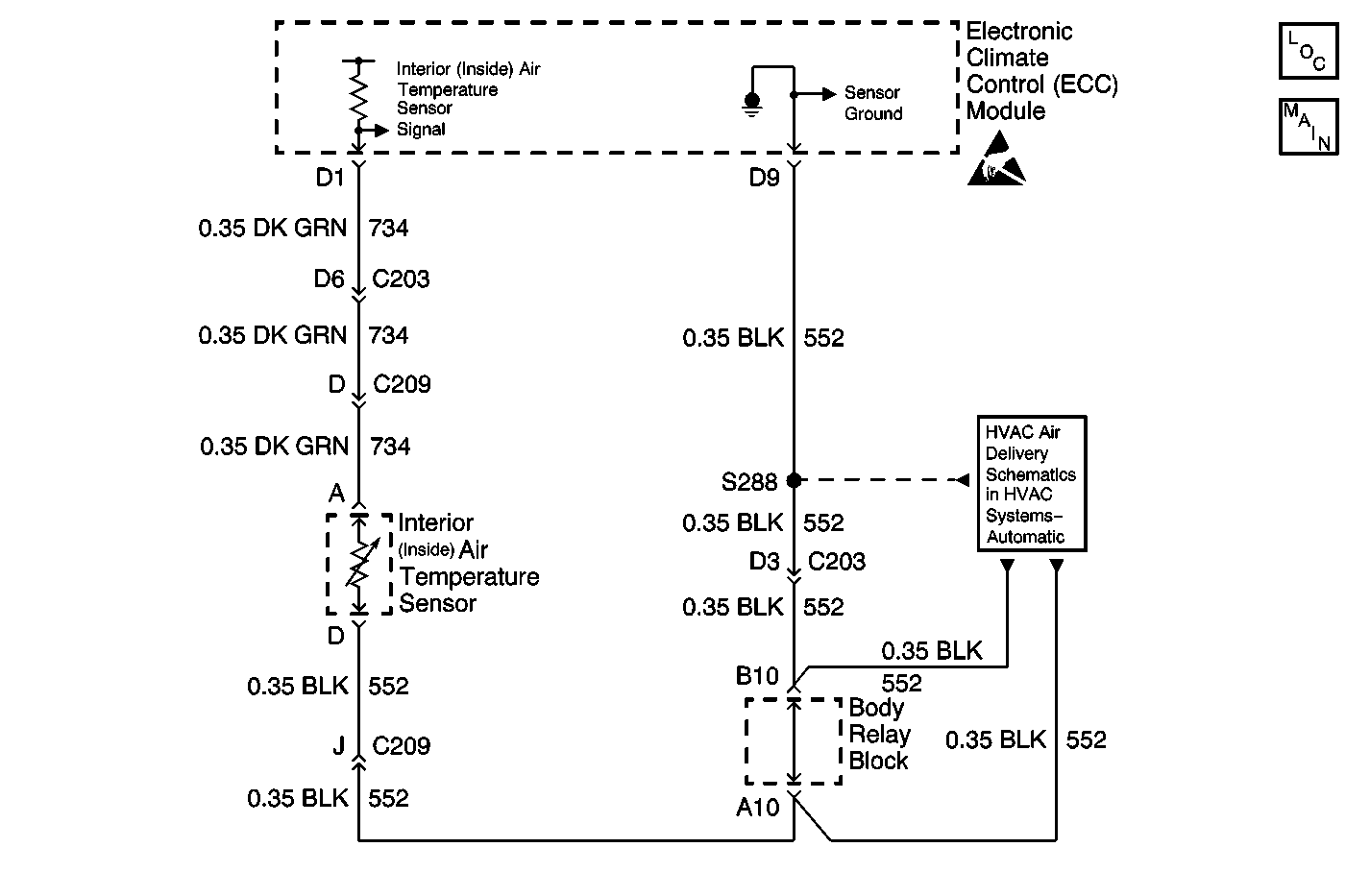
Circuit Description
The HVAC control module monitors the inside air temperature via an inside air temperature sensor. When the air is cold, the sensor resistance and the signal voltage are high. When the air is warm, the sensor resistance and the signal voltage are low. The HVAC control module requests the A/C compressor clutch engagement and controls the air temperature door positions in order to maintain the temperature selected on the HVAC control module.
Conditions for Running the DTC
The ignition is turned ON.
Conditions for Setting the DTC
The HVAC control module detects the fault whenever the temperature is more than 80° C (176° F).
Action Taken When the DTC Sets
The HVAC control module uses a default temperature sensor value of -53° C (-65° F) until the fault is cleared.
Conditions for Clearing the DTC
| • | The DTC becomes history when the HVAC control module no longer detects a failure. |
| • | The history DTC clears after 50 fault-free ignition cycles. |
| • | The DTC can be cleared with a scan tool. |
Diagnostic Aids
| • | Visually inspect the sensor connector and harness for corrosion and damage. The resistance value of the sensor must be 47-101,000 ohms. If the resistance is not within the specified value, replace the sensor. |
| • | Insure inside air temperature sensor is in place and secure. Insure no restrictions or debris around inside air temperature sensor this will give incorrect reading to HVAC control module. |
| • | If condition is not present refer to Testing for Intermittent Conditions and Poor Connections in Wiring Systems. |
Test Description
The number(s) below refer to the step number(s) on the diagnostic table.
-
Tests for the proper operation of the circuit in the high voltage range.
-
Tests for the proper operation of the circuit in the low voltage range. If the fuse in the jumper opens when you perform this test, the signal circuit is shorted to voltage.
Step | Action | Value(s) | Yes | No |
|---|---|---|---|---|
1 | Did you perform the HVAC Diagnostic System Check? | -- | Go to Step 2 | Go to Diagnostic System Check |
2 |
Does the scan tool indicate that the Inside Air Temperature parameter is within the specified range? | -40° to 80° C (-40° to 176° F) | Go to Diagnostic Aids. | Go to Step 3 |
Does the scan tool indicate that the Inside Air Temperature parameter is less than the specified value? | -40° C (-40° F) | Go to Step 4 | Go to Step 5 | |
Does the scan tool indicate that the Inside Air Temperature parameter is less than the specified value? | 80° C (176° F | Go to Step 8 | Go to Step 6 | |
5 | Test the signal circuit of the inside air temperature sensor for a short to ground. Refer to Circuit Testing and Wiring Repairs in Wiring Systems. Did you find and correct the condition? | -- | Go to Step 12 | Go to Step 9 |
6 | Test the signal circuit of the inside air temperature sensor for a short to voltage, a high resistance, or an open. Refer to Circuit Testing and Wiring Repairs in Wiring Systems. Did you find and correct the condition? | -- | Go to Step 12 | Go to Step 7 |
7 | Test the low reference circuit of the inside air temperature sensor for a high resistance or an open. Refer to Circuit Testing and Wiring Repairs in Wiring Systems. Did you find and correct the condition? | -- | Go to Step 12 | Go to Step 9 |
8 | Inspect for poor connections at the harness connector of the inside air temperature sensor. Refer to Testing for Intermittent Conditions and Poor Connections and Special Tools in Wiring Systems. Did you find and correct the condition? | -- | Go to Step 12 | Go to Step 10 |
9 | Inspect for poor connections at the harness connector of the HVAC control module. Refer to Testing for Intermittent Conditions and Poor Connections and Special Tools in Wiring Systems. Did you find and correct the condition? | -- | Go to Step 12 | Go to Step 11 |
10 | Replace the inside air temperature sensor. Refer to Inside Air Temperature Sensor Replacement . Did you complete the replacement? | -- | Go to Step 12 | -- |
11 | Replace the HVAC control module. Refer to Control Assembly Replacement . Did you complete the replacement? | -- | Go to Step 12 | -- |
12 |
Does the DTC reset? | -- | Go to Step 2 | System OK |
